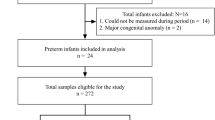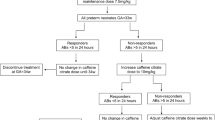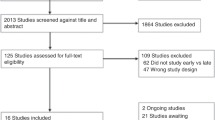Abstract
Objective:
Caffeine is effective in the treatment of apnea of prematurity but it is not well known if the therapeutic concentration of the drug has an impact on other neonatal outcomes such as chronic lung disease (CLD). The aim of this study was to determine if there is an association between caffeine concentrations and the incidence of CLD in premature infants of ⩽29 weeks of gestation.
Study design:
A retrospective chart review of all the infants born ⩽29 weeks of gestation from 2007 to 2011, who survived until discharge or 36 weeks postmenstrual age, was conducted. Caffeine concentrations were obtained weekly on infants getting the drug. Average caffeine concentrations (ACCs) were determined for the duration of caffeine therapy and correlated with CLD, length of stay (LOS), oxygen at discharge (OD), duration of ventilation (DV) and total charges for hospitalization for each patient.
Results:
Of the 222 eligible infants, 198 met the inclusion criteria. ACC for infants without CLD was 17.0±3.8 μg ml−1 compared with infants with CLD 14.3±6.1 μg ml−1 (P<0.001). Infants receiving high ACC (>14.5 μg ml−1) had lower incidence of patent ductus arteriosus, lesser number of days on ventilator and oxygen, lesser need for diuretics, lower incidence of CLD, were more likely to go home without supplemental OD and had lower LOS and lower total hospital charges (all differences were significant P<0.05) Multiple logistic regression modeling after adjusting for confounding variables indicated that higher caffeine concentrations were significantly associated with decrease in CLD. Receiver operating curve analysis confirmed a significant predictive ability of caffeine concentration for CLD with a cutoff concentration of 14.5 μg ml−1 (sensitivity of 42.6 and specificity of 86.8). The AUC (area under the curve) for the prediction of CLD was 0.632 (95% confidence interval 0.56–0.69, P=0.009).
Conclusions:
Caffeine concentrations >14.5 μg ml−1 were strongly correlated with reduced CLD in infants born at ⩽29 weeks of gestation. Higher caffeine concentrations were associated with decreased total hospital charges, DV, OD and LOS. Additional randomized trials are needed to confirm these findings, to identify ideal serum concentrations and determine possible long-term neurologic benefits.
This is a preview of subscription content, access via your institution
Access options
Subscribe to this journal
Receive 12 print issues and online access
$259.00 per year
only $21.58 per issue
Buy this article
- Purchase on Springer Link
- Instant access to full article PDF
Prices may be subject to local taxes which are calculated during checkout

Similar content being viewed by others
References
Jacobson KA . Introduction to adenosine receptors as therapeutic targets. Handb Exp Pharmacol 2009; (193): 1–24; PMCID: PMC3415694.
Rivkees SA, Zhao Z, Porter G, Turner C . Influences of adenosine on the fetusand newborn. Mol Genet Metab 2001; 74 (1-2): 160–171.
Schmidt B, Roberts RS, Davis P, Doyle LW, Barrington KJ, Ohlsson A et al. Caffeine therapy for apnea of prematurity. N Engl J Med 2006; 354 (20): 2112–2121.
Schmidt B, Roberts RS, Davis P, Doyle LW, Barrington KJ, Ohlsson A et al. Long-term effects of caffeine therapy for apnea of prematurity. N Engl J Med 2007; 357 (19): 1893–1902.
Natarajan G, Botica ML, Thomas R, Aranda JV . Therapeutic drug monitoring for caffeine in preterm neonates: an unnecessary exercise? Pediatrics 2007; 119 (5): 936–940.
Chavez Valdez R, Ahlawat R, Wills-Karp M, Nathan A, Ezell T, Gauda EB . Correlation between serum caffeine levels and changes in cytokine profile in a cohort of preterm infants. J Pediatr 2011; 158 (1): 57–64, 64 e51.
Du Y, Melchert HU, Knopf H, Braemer-Hauth M, Pabel E . Association of serum caffeine concentrations with serum glucose levels in caffeine-drug users and non-users - results of German National Health Surveys. Diabetes Obes Metab 2007; 9 (5): 756–758.
Cao C, Loewenstein DA, Lin X, Zhang C, Wang L, Duara R et al. High Blood caffeine levels in MCI linked to lack of progression to dementia. J Alzheimers Dis 2012; 30 (3): 559–572.
Tiwari KK, Chu C, Couroucli X, Moorthy B, Lingappan K . Differential concentration-specific effects of caffeine on cell viability, oxidative stress, and cell cycle in pulmonary oxygen toxicity in vitro. Biochem Biophys Res Commun 2014; 450 (4): 1345–1350.
Banerjee P, Ali Z, Levine B, Fowler DR . Fatal caffeine intoxication: a series of eight cases from 1999 to 2009. J Forensic Sci 2014; 59 (3): 865–868.
al-Alaiyan S, al-Rawithi S, Raines D, Yusuf A, Legayada E, Shoukri MM et al. Caffeine metabolism in premature infants. J Clin Pharmacol 2001; 41 (6): 620–627.
Aranda JV, Collinge JM, Zinman R, Watters G . Maturation of caffeine elimination in infancy. Arch Dis Child 1979; 54 (12): 946–949.
Bancalari E, Abdenour GE, Feller R, Gannon J . Bronchopulmonary dysplasia: clinical presentation. J Pediatr 1979; 95 (5 Pt 2): 819–823.
Papile LA, Burstein J, Burstein R, Koffler H . Incidence and evolution of subependymal and intraventricular hemorrhage: a study of infants with birth weights less than 1,500 gm. J Pediatr 1978; 92 (4): 529–534.
DeReuck J, Chattha AS, Richardson EP Jr . Pathogenesis and evolution of periventricular leukomalacia in infancy. Arch Neurol 1972; 27 (3): 229–236.
Bell MJ, Ternberg JL, Feigin RD, Keating JP, Marshall R, Barton L et al. Neonatal necrotizing enterocolitis. Therapeutic decisions based upon clinical staging. Ann Surg 1978; 187 (1): 1–7.
Patz A . New international classification of retinopathy of prematurity. Pediatrics 1984; 74 (8): 160–161.
Aranda JV, Beharry K, Valencia GB, Natarajan G, Davis J . Caffeine impact on neonatal morbidities. J Matern Fetal Neonatal Med 2010; 23 (Suppl 3): 20–23.
Dobson NR, Patel RM, Smith PB, Kuehn DR, Clark J, Vyas-Read S et al. Trends in caffeine use and association between clinical outcomes and timing of therapy in very low birth weight infants. J Pediatr 2014; 164 (5): 992–998.
Schmidt B, Davis PG, Roberts RS . Timing of caffeine therapy in very low birth weight infants. J Pediatr 2014; 164 (5): 957–958.
Li J, Li G, Hu JL, Fu XH, Zeng YJ, Zhou YG et al. Chronic or high dose acute caffeine treatment protects mice against oleic acid-induced acute lung injury via an adenosine A2A receptor-independent mechanism. Eur J Pharmacol 2011; 654 (3): 295–303.
Miller JL, Nandyal RR, Anderson MP, Escobedo MB . Relationship of caffeine dosing with serum alkaline phosphatase levels in extremely low-birth-weight infants. J Pediatr Pharmacol Ther 2012; 17 (1): 58–66.
Ginsberg G, Hattis D, Sonawane B, Russ A, Banati P, Kozlak M et al. PBPK modelling of caffeine and theophylline in neonates and adults: implications for assessing children's risks from environmental agents. J Toxicol Environ Health Part A 2004; 67 (4): 297–329.
Cazeneuve C, Pons G, Rey E, Treluyer JM, Cresteil T, Thiroux G et al. Biotransformation of caffeine in human liver microsomes from foetuses, neonates, infants and adults. Br J Clin Pharmacol 1994; 37 (5): 405–412.
Thorn CF, Aklillu E, McDonagh EM, Klein TE, Altman RB . PharmGKB summary: caffeine pathway. Pharmacogenet Genomics 2012; 5 (5): 389–395.
Leon AE, Michienzi K, Ma CX, Hutchison AA . Serum caffeine concentrations in preterm neonates. Am J Perinatol 2007; 24 (1): 39–47.
Patel RM, Leong T, Carlton DP, Vyas-Read S . Early caffeine therapy and clinical outcomes in extremely preterm infants. J Perinatol 2013; 33 (2): 134–140.
Chavez-Valdez R, Wills-Karp M, Ahlawat R, Cristofalo EA, Nathan A, Gauda EB . Caffeine modulates TNF-alpha production by cord blood monocytes: the role of adenosine receptors. Pediatr Res 2009; 65 (2): 203–208.
Eckle T, Faigle M, Grenz A, Laucher S, Thompson LF, Eltzschig HK . A2B adenosine receptor dampens hypoxia-induced vascular leak. Blood 2008; 111 (4): 2024–2035.
Sitkovsky M, Lukashev D . Regulation of immune cells by local-tissue oxygen tension: HIF1 alpha and adenosine receptors. Nat Rev Immunol 2005; 5 (9): 712–721.
Crossley KJ, Allison BJ, Polglase G, Morley CJ, Harding R, Davis PG et al. Effects of caffeine on renal and pulmonary function in preterm newborn lambs. Pediatr Res 2012; 72: 19–25.
Kassim Z, Greenough A, Rafferty GF . Effect of caffeine on respiratory muscle strength and lung function in prematurely born, ventilated infants. Eur J Pediatr 2009; 168 (12): 1491–1495.
Rivkees SA, Wendler CC . Adverse and protective influences of adenosine on the newborn and embryo: implications for preterm white matter injury and embryo protection. Pediatr Res 2011; 69 (4): 271–278.
Clyman RI, Roman C . The effects of caffeine on the preterm sheep ductus arteriosus. Pediatr Res 2007; 62 (2): 167–169.
Geraets L, Moonen HJ, Wouters EF, Bast A, Hageman GJ . Caffeine metabolites are inhibitors of the nuclear enzyme poly(ADP-ribose)polymerase-1 at physiological concentrations. Biochem Pharmacol 2006; 72 (7): 902–910.
Micallef S, Amzal B, Bach V, Chardon K, Tourneux P, Bois FY . Sequential updating of a new dynamic pharmacokinetic model for caffeine in premature neonates. Clin Pharmacokinet 2007; 46 (1): 59–74.
Acknowledgements
We thank Ms Gaye Ludwig and Diane Myers for their proof reading and formatting help.
Author Contributions
PA was responsible for the conception, design, acquisition, analysis and interpretation of the data, and also for the drafting and final revision of the manuscript. VB was responsible for the acquisition of data and interpretation. TB and NH performed the statistical analysis and interpreted the data. JL was responsible for the design, analysis and interpretation of data. VB and TB were responsible for the final revision of the manuscript. NH was responsible for review and final revision of the manuscript. JL was responsible for the drafting and final revision of the manuscript. All authors have provided the final approval of the manuscript.
Author information
Authors and Affiliations
Corresponding author
Ethics declarations
Competing interests
The authors declare no conflict of interest.
Rights and permissions
About this article
Cite this article
Alur, P., Bollampalli, V., Bell, T. et al. Serum caffeine concentrations and short-term outcomes in premature infants of ⩽29 weeks of gestation. J Perinatol 35, 434–438 (2015). https://doi.org/10.1038/jp.2014.226
Received:
Revised:
Accepted:
Published:
Issue Date:
DOI: https://doi.org/10.1038/jp.2014.226
This article is cited by
-
Serum caffeine concentrations in preterm infants: a retrospective study
Scientific Reports (2023)
-
Caffeine dosing in premature neonates: impact of birth weight on a pharmacokinetic simulation study
Pediatric Research (2023)
-
Caffeine: an evidence-based success story in VLBW pharmacotherapy
Pediatric Research (2018)
-
Can the preterm lung recover from perinatal stress?
Molecular and Cellular Pediatrics (2016)
-
Apnea of prematurity and caffeine pharmacokinetics: potential impact on hospital discharge
Journal of Perinatology (2016)



